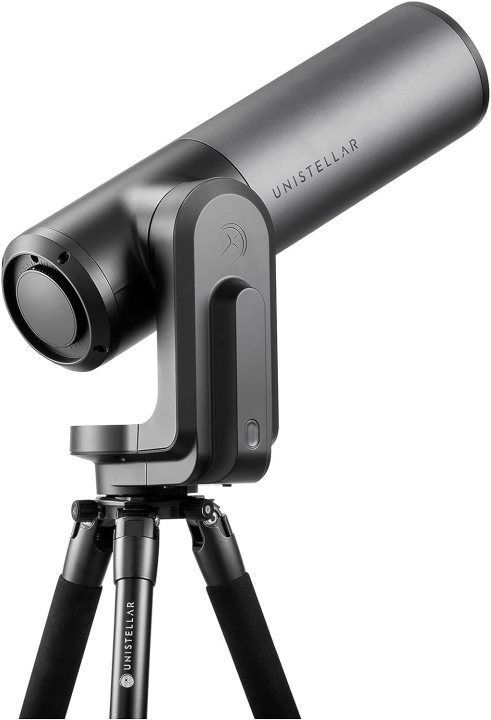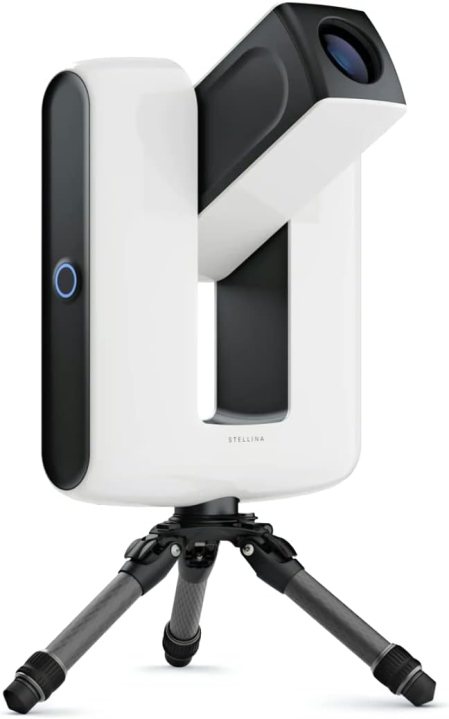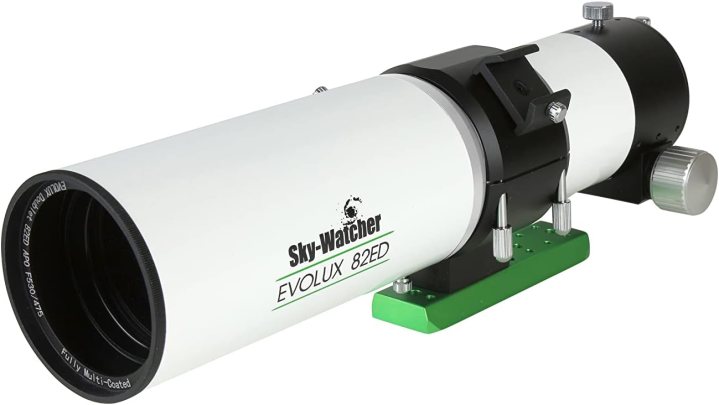
The Best Telescope for Astrophotography in 2024
- Buy the Sky-Watcher Skymax 180mm if you want to photograph objects within the solar system.
-
Buy the Unistellar eVscope eQuinox if you want a smart telescope.
-
Buy the Explore Scientific ED127 if you want to photograph planets.
-
Buy the Vaonis Stellina Observation Station if you want an automated system.
-
Buy the Sky-Watcher Evolux 82ED if you want an affordable and portable option.
Sky-Watcher Skymax 180mm
Best telescope to photograph objects within the solar system

| Pros | Cons |
| Powerful for viewing objects in the solar system | No mount included |
| Crisp images | Expensive |
| Can view nebulae and galaxies too |
If you’re interested in photographing objects within the solar system, then the Sky-Watcher Skymax 180mm is a classic choice. With its 180mm aperture, this reflector telescope has a long focal length of 2700mm despite its fairly compact size, coming it at just over 76 cm long. It’s ideal for imaging the moon or the planets, and it offers excellent, clear views of those. If you’re interested in occasionally imaging brighter deep sky objects like galaxies and nebulae too then it can handle those, but if these are your main area of interest then you might want to look elsewhere.
The Skymax isn’t cheap, and it’s a higher-end option which assumes you already have equipment like a mount that you can use as no mount is included, and this can be a pricey extra. It does come with a finderscope and an adapter so it’s easy to attach your camera and start taking images once you’ve located the objects you’re interested in. As a Maksutov-Cassegrain style telescope it’s ideal for offering high quality views in a relatively compact package.
Unistellar eVscope eQuinox
Best smart telescope for astrophotography

| Pros | Cons |
| Sophisticated software | App experience not for everyone |
| Bright images | Expensive |
| Can handle light pollution |
Explore Scientific ED127
Best telescope for photographing planets

| Pros | Cons |
| Portable, with handle | No mount included |
| Powerful for space objects of all kinds | |
| Easily mount a camera |
For those who are keen to photograph our solar system’s beautiful planets, then the Explore Scientific ED127 is a front runner choice. With its 127mm aperture and optical tube length of 41.75 inches, it’s a favorite pick among astrophotographers for its power and beautiful sharp images. It’s relatively portable as well, weighing in at 18 lbs and coming with a handle. So don’t expect to be toting it effortless on a long hike, but it’s easy enough to take out into a rural area and carry for a short distance to get set up.
It generates particularly good images in terms of contrast, and it has a adapter than fits some but not all cameras. Bear in mind that you may need a separate mount depending on what camera you’re planning to use it with. There’s also no mount included, so you’ll need to supply your own additional hardware to get this set up. This isn’t a cheap choice but it is a solid piece of hardware from a reputable brand, and it’ll help you take great photos of both planets and some more distant objects like galaxies of medium brightness.
Vaonis Stellina Observation Station
Best telescope for automated imaging

| Pros | Cons |
| Full automated | Takes the fun out of setup for some |
| Hands free, no setup | |
| Smart, attractive package |
How We Chose These Telescopes for Astrophotography
Astrophotography is a highly technical hobby, with many factors to consider when choosing a telescope. From what kinds of objects you’re hoping to photograph, to how much you have to spend, to the conditions you’ll be taking images in, there’s no one option that will be right for everyone. So we’ve considered a range of factors and shared recommendations based on the particular needs of different people trying out astrophotography, whether they are experienced users or newbies looking to get started in the hobby.
Imaging within the solar system or deep space
Most telescopes in this kind of bracket should be able to handle imaging nearby objects like the moon and brighter planets with no problem at all, but if you want to photograph more distant objects like galaxies and nebulae, you need to consider the power of a telescope. A large aperture, typically measured in mm, is key to photographing fainter objects, with more power required for these more distant objects. But you should also consider the focal ratio, or f-ratio, of a telescope, as different targets give off different amounts of light and you need to balance brightness with magnification.
Additional hardware required
A most traditional astrophotography telescope will come with just the telescope and a way to mount your camera, plus perhaps a telescope mount. You’ll generally be expected to have your own DSLR camera that you use for these projects, and some kind of tripod to get everything set up as well. If you’ve been in the hobby for a while then you likely have a lot of this extra kit already and have strong feelings about your preferred setup.
However, if you’re newer to the hobby and you don’t have all the kit yet then there are other options available to you. You’ll find some complete systems which include cameras within them, like the Stellina system, or other telescopes which you can use with your smartphone to take photographs. Smartphone cameras have come a long way in the last decade and many people take incredible astrophotography images with a smartphone, so don’t feel like you need to shell out on both a telescope and a new camera if you want to get started trying out your hand at photographing astronomical objects.
Portability, format, and weight
It’s worth thinking about the practical scenarios in which you’re planning to use your telescope. Do you live somewhere quiet and rural, with low light pollution and a large outdoor space? Then you could create a great setup in your own backyard, using larger and heavier equipment that you only need to move from the house to the garden when you want to take photographs. But if you live in the city and are looking for a telescope that you can take with you on weekend hikes or camping trips, then you don’t want to be lugging around something enormous and heavy. A lighter weight, more portable option will serve you better even if it’s not quite as powerful as alternatives.
Of course, whatever format you pick, you’ll want a telescope which offers great image quality and which is easy to use. Whether it’s controlled by an app or by manual adjustment, the difference between a telescope which is easy to work with and one which is finicky can be the different between a relaxing and beautiful night photographing the stars and a series of frustrations.
This article is managed and created separately from the Digital Trends Editorial team.




